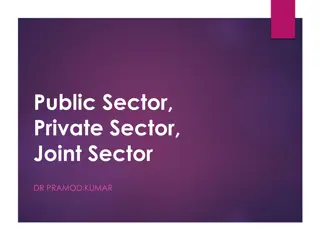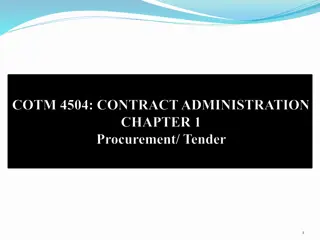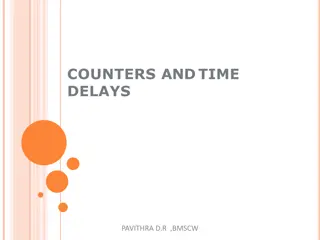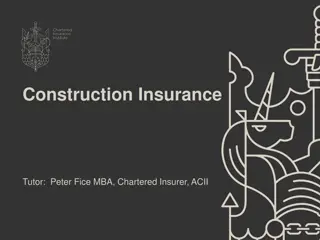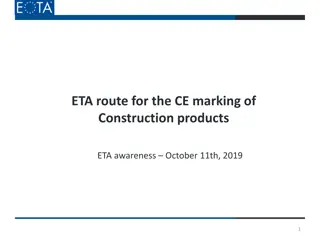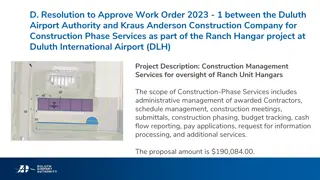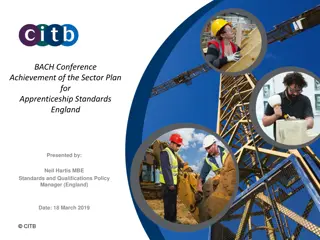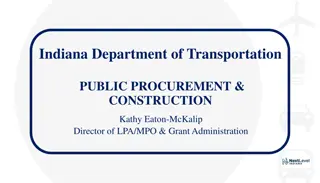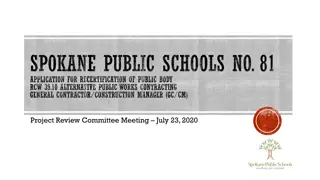Understanding Delays in Free State Public Sector Construction Projects
The presentation by Dr. Phillip Lesia explores the causes of delays in Free State public sector construction projects, impacting economic growth and development. Despite government interventions, projects continue to face setbacks leading to disputes, cost overruns, and loss of productivity. The study emphasizes the importance of timely infrastructure delivery for overall prosperity and highlights key findings and recommendations.
Download Presentation

Please find below an Image/Link to download the presentation.
The content on the website is provided AS IS for your information and personal use only. It may not be sold, licensed, or shared on other websites without obtaining consent from the author. Download presentation by click this link. If you encounter any issues during the download, it is possible that the publisher has removed the file from their server.
E N D
Presentation Transcript
Delays in the Free State public sector construction projects and their causes Presented at: 5th Annual Free State Provincial Research Colloquium, 28-29 September 2022 Presentation by Dr. Phillip Lesia, Ph.D.
Presentation Outline Background Statement of the problem Aim of the study Literature review Methodology Results/findings Conclusions and recommendations
Background (1) Infrastructure delivery is the backbone of economic growth and development.
Background (2) A large body of literature shows that there is a positive relationship between an increase in infrastructure investment and economic growth. For instance, Aschauer (1989) finds that the slump in U.S. economic growth in the 1970s & 80s is attributable to low government spending on public infrastructure. These findings were confirmed by earlier studies by Holtz-Eakin (1988), Munnell (1990), Eisener (1991), Eberts (1986,1990), and Gramlich (1994) Therefore, an increase in government spending on infrastructure investment has become a valid tool for policymakers advocating for an increase in government spending.
Problem Statement [1] Due to the recurring delays in the delivery of infrastructure projects, fully functional infrastructure facilities are not delivered on time Resulting in the downshifting of economic activities, and loss of employment opportunities. The persistent delays in infrastructure projects are evident in poor maintenance of existing assets and poor service delivery. The inability of projects to be delivered on time has led to disputes and litigation between the parties, cost overruns/escalation, loss of productivity and revenue/profit, and contract termination. (Akogbe et al., 2013; Dolage & Pathmarajah, 2015; Gonzalez et al., 2014; Gunduz et al., 2015; Sweis, 2008; Ullah et al., 2018).
Problem Statement [2] The delivery of infrastructure projects on time in the Free State public sector is a cause for concern for policymakers. This continues to happen despite government policy interventions and tools to improve infrastructure delivery such as Infrastructure Delivery Improvement Programme (IDIP) (2003), Infrastructure Delivery Management Toolkits (200,4,2006 and 2006), the Cities IDMS (CIDMS) (2016), Standard for Infrastructure Procurement and Delivery Management (SIPDM) in 2015, a Framework for Infrastructure Delivery and Procurement Management (FIDPM) (2019) and CIDB Standard for Uniformity in Engineering and Construction Works Contract (2019)
Aim of the study To investigate the main causes of construction project delays in the Free State public sector. The study also fills an existing gap in the body of knowledge by investigating the causes of delays in the Free State public sector construction projects.
Literature Review (1) Origins of Delays Caused by either internal or external factors or both which differ from project to project (Ahmed et al., 2003; Rafieizonooz et al., 2015; Motaleb & Kishk, 2010:1149). Internal causes are related to customers, designers, service providers, and consultants are regarded as internal causes External causes are related to climate issues, suppliers We are dealing with the four Cs These four Cs are internal And then we have eternal causes which are related to labour, material as well as external factors.
Literature Review (2) Summary of the major causes Client-related, contractor-related, consultant-related, materials- related, labour and equipment-related, contract-related, contract relationship-related and external-related (Mohammed & Isah, 2012; Hasseb et al., 2011; Pourrostam & Ismail, 2011; Fugar & Agyakwah-Baah, 2010; Motaleb & Kishk, 2010; Tumi et al., 2009; Le-Hoai et al., 2008; Sambasivan & Soon, 2007; Assaf & Al- Hejji, 2006; Koushki et al., 2005; Alwi & Hampson, 2003; Al-Khalil & Al-Ghafty,1999).
Literature Review (3) AROUND THE WORLD Summary of findings Main findings improper planning; lack of communication; design errors; late payments, slow decision-making Sambasivan & Soon (2007); Pourrostam & Isamail (2011) Mohammed & Isah (2012); Odeh & Battaineh (2002); Al- Khalil & Al-Ghafly (1999 Main effects time overrun, cost overruns
Literature Review (4) AFRICA Summary of main findings Lack of effective communication, improper planning; design errors; late payment; corruption; shortage of materials; political instability; strikes Main effects time overrun, cost overruns
Literature Review (5) SOUTH AFRICA Summary of findings Design changes; late payments; slow decision-making; high cost of capital; strikes; contractor underperformance Olatunji (2010); Baloyi & Bekker (2011); Ballong (2008); Main effects time overrun, cost overruns
Methodology The data utilized in this paper were derived from both primary and secondary sources. The secondary data was collected through extensive literature about the causes of delays in construction projects. Sets of causes that are potentially relevant causes of delays were identified from the summary of the comprehensive literature review from both developed and developing countries. The questionnaire was developed based on the literature. Fifty-seven (57) related causes of delays in the Free State public sector were identified and grouped into seven categories. Then, the primary data was collected from infrastructure experts in six sector departments using the Delphi technique. These causes of delays found in the empirical study done in the Free State public sector construction projects were then ranked in each group from the viewpoint of experts in the public sector. 2
Summarized Findings (1) Client-related causes Major findings: Late payments of completed work. Poor budgeting. Poor budget planning by the cliental departments for the period after Works Completion up to Close Out of a project. Inadequate capacity and ability of procured Service Providers. Over-commitment of contractors or service providers. Scope changes during the course of the project. Level of detail contained in Project Brief i.t.o. project scope. Clients often hand over projects without knowing their scope and intend to refine or review their scope while they are underway. Non-adherence to the FIDPM, IDMS and CIDB requirements and prescripts emanating from a weak supply chain and tender processes. Slow decision-making. Getting approval of projects by the client department can take a very long time. This happens especially if approval is required from their National Department. Another issue is the time taken to conclude procurement. Government procurement documents usually require a validity period of at least 90 days for tenders. Procurement processes are rarely concluded within this period, resulting in the start of the project being delayed. 2
Summarized Findings (2) Contractor-related cause Major findings: Contract Management non-adherence to the terms of the contract i.r.o. milestone dates, cash flow and the contract amount Inadequate contractor experience Inadequate financial capacity to fund the start of the contract and to maintain continuity of work in the event of late payments by the client. Contractors are over-committing themselves. Contractors taking on more work than they can finance or have resources for inevitably result in project failure or delay of completion. Poor evaluation and adjudication practices applied when evaluating tenders as there is not adherence to CIDB prescripts, especially tender risk assessments resulting in contractors being appointed without the required resources. Inadequate technical capacity to execute contract works either in terms of scope or complexity of work. Project Management non-adherence to scope, specifications and quality of work required by drawings, specifications and Bills of Quantities 2
Summarized Findings (3) Consultant-related causes Major findings: Finalization of final accounts, completion certificates and project close-out as required by the IDMS. Inadequate quality assurance or control. Contract management Non-implementation of IDMS gateway approval system Preparation and approval of drawings. Contract-related Findings: Utilizing incorrect contract formats that do not fit the purpose (Mistakes and discrepancies in contract documents). Variation orders. Sometimes, this emanates from the client s interference when the client oversteps his/he delegation and makes changes during the duration of the project. This can happen as a result of inadequate or unclear brief, and changes in plan or scope. Quality and alignment of Drawings, Specifications, and Bills of Quantities. 2
Summarized Findings (4) Materials-related causes Major findings: Late procurement of materials due to poor or inadequate resource planning by the Contractor Quality of material non-compliance with Consultants specifications, drawings or Bill of Quantities Shortage of material Delay in material delivery Delay in manufacturing special building materials Labour and equipment-related causes Major Findings: Labour disputes and strikes Labour supply Labour productivity Equipment availability and failure 2
Summarized Findings (5) External-related causes Major findings: Community unrest or entitlement Unforeseen site condition Hi-jacking of projects by community business forums or sub-contractors. This is a new tendency amongst opportunistic groups who by violent means attempts to force contractors to surrender a part of the work on a project. This situation results in projects being closed down until the law has dealt with the perpetrators. Weather conditions Regulatory changes 2
Policy Recommendations (1) Client-related causes To improve the situation regarding delayed payments, finances can be shifted from the client/sector departments to the implementing department. Furthermore, it would be crucial that implementing agents follow the IDMS stages and gates to ensure that proper documentation are submitted in time to the client departments so that payments can be made in time to the service providers. Contractor-related causes To address the contractor-related causes, the appointment of suitable contractors entails that the contract time and value are in line with the affordability of the contractor. The contractor needs to have a certain cash flow float to be able to incur expenditure and afford to be refunded after 60 days. Once this refunded time exceeds the 60-day period the loss in interests as well as the reduced affordability results in cash flow failures and the risk of the project being delayed. In relation to the sub-contractors, enforcing a contractor to comply with the appointment of sub-contractors that is related to a specific area. In addition, sub-contractors should be sourced in such a way as to motivate the future maintenance of a facility. This way the motivation is there to do a better job (as they will be involved with maintenance) and the expertise would be closely available. 7
Policy Recommendations (2) Consultant-related causes Local consultants foresee a relationship with the product and the use thereof. The closer they are to the project (building s value) the better their intention to ensure a viable product. Again if some professional is associated with scheduled maintenance of a facility, their dedication changes to that of ensuring quality, so that they have fewer frustrations in the near future. Contract-related causes There is a need for government to generate its own contract documentation to manage and steer all projects in the built environment. The use of specific JBCC or GCC, or FIDIC or NEC contracts are of great value but not tailored to be correct. For instance, JBCC says 21 days to pay but government works says 30 days (PFMA). 7
Policy Recommendations (3) Materials and equipment related causes Smaller projects need to be approached with two parts; a material buy part and a labour part. Government should purchase the materials for minor projects and only appoint a contractor for installations. This way the best practice labour contractor can be promoted and the risk associated with material delays is avoided as the materials are obtained prior to contract commencement. The involved QS could be held responsible for the material issue and payments of activities and results. Project s that suffers from the inadequate performance can then be stopped and alternative labour obtained with minimal effects on costs and legal battles that in all consumes money and time. The involvement of the EPWP would be crucial to engage in the programs where labourers are sourced for contractor participation and grading improvement in terms of their CIDB category compliance. Government is unique in operation and should be seen as such. The norm in the built environment should not be applied blindly, especially if that norm is associated with foreign countries. 7
Thank you Thank you 11







